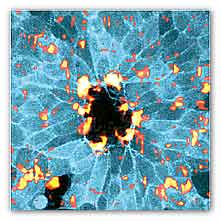News and Insights for
your best life. Online since 1998
- Home Health
- Breaking news
- In caso di...
- Per saperne di
più... - Medicina occidentale
- Medicine complementari
- Medicina cinese
e agopuntura - Omeopatia
- Fitoterapia

A fundamental feature of multicellular organisms is their ability to self-repair wounds through the movement of epithelial cells into the damaged area. This collective cellular movement is commonly attributed to a combination of cell crawling and ‘purse-string’ contraction of a supracellular actomyosin ring.

Researchers showed by direct experimental measurement that these two mechanisms are insufficient to explain force patterns observed during wound closure.
At early stages of the process, leading actin protrusions generate traction forces that point away from the wound, showing that wound closure is initially driven by cell crawling. At later stages, researchers observed unanticipated patterns of traction forces pointing towards the wound.
Such patterns have strong force components that are both radial and tangential to the wound. Researchers showed that these force components arise from tensions transmitted by a heterogeneous actomyosin ring to the underlying substrate through focal adhesions.
The structural and mechanical organization reported in the study provides cells with a mechanism to close the wound by cooperatively compressing the underlying substrate.
For more information
nature physics
Forces driving epithelial wound healing
Institut de Bioenginyeria de Catalunya
UPC. Universitat Politècnica de Catalunya · BarcelonaTech
MDN
del Dott. Turetta
Quali sono i problemi o le disfunzioni che possono giovarsi di un intervento omeopatico d'urgenza e, di conseguenza, come dovrebbe essere un ideale armadietto medicinale omeopatico casalingo.- Home -
- Health -
- Depressione -
- Sexuality
- Environment -
- Food -
- Musica -
- Capirsi -
- Grafologia -
- Ridere
Copyright © 1998/2018 www.mybestlife.com tutti i diritti sono riservati eccetto quelli già di altri proprietari.
.In caso di
Pubblicità
Per saperne di più su
Pubblicità
Pubblicità
Pubblicità
Pubblicità


